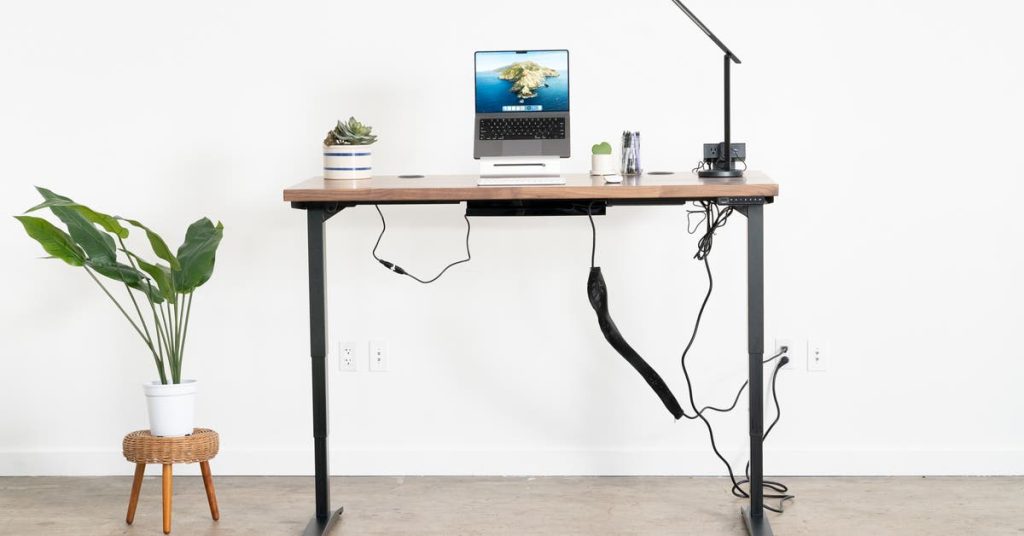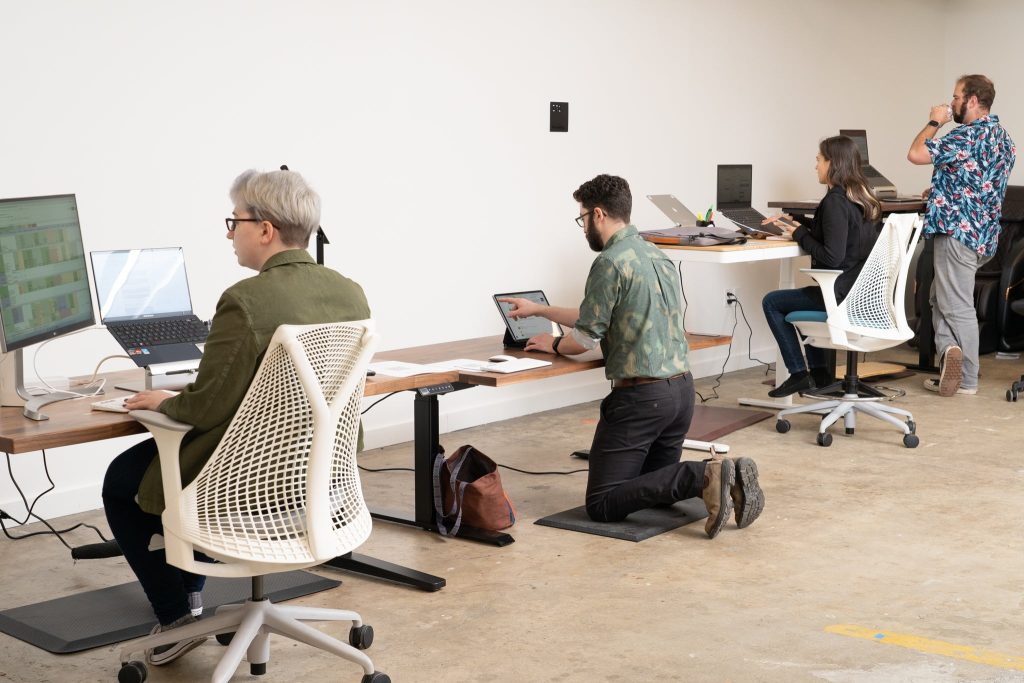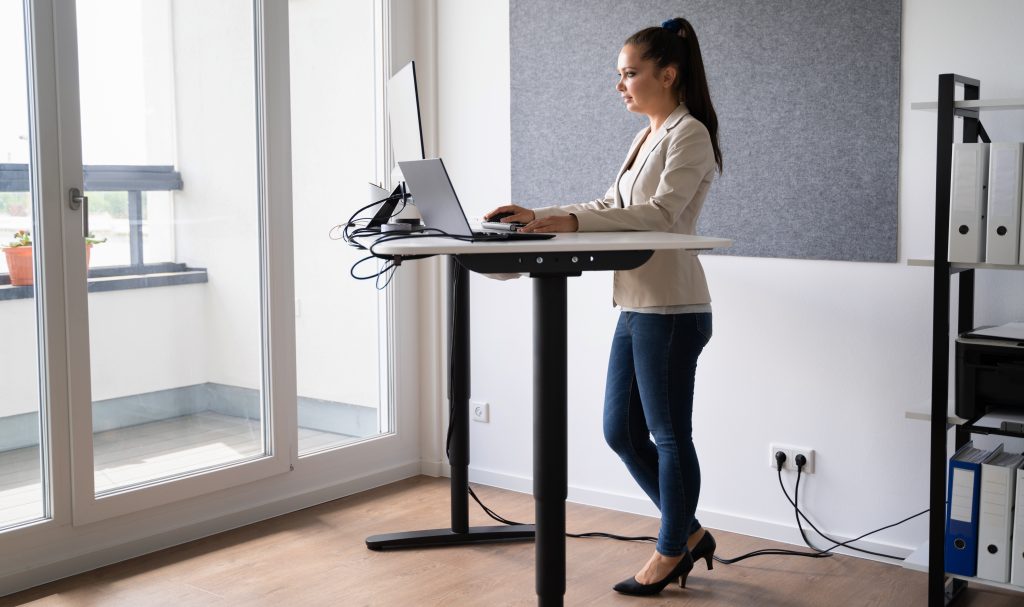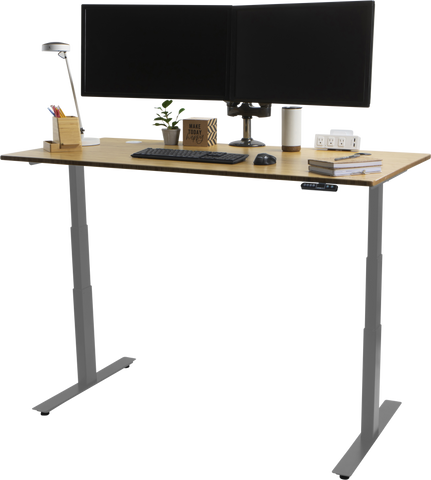No products in the cart.
Height Adjustable Desks, Standing Desk Converters, Standing Desks
Choosing the Right Standing Desk for Your Office
Are you tired of sitting at your desk all day? A standing desk could be the solution you’ve been searching for. In this article, we will explore the different factors to consider when choosing the right standing desk for your office. From adjustable height options to ergonomic designs, we’ll provide you with all the information you need to make an informed decision. Say goodbye to a sedentary lifestyle and hello to improved productivity and overall well-being!

Considerations before Choosing a Standing Desk
Ergonomics
When choosing a standing desk, one of the most important considerations is ergonomics. It’s crucial to select a desk that promotes proper posture and reduces strain on your body. Look for desks that allow for height-adjustability, so you can find the perfect position for your height and work setup. Additionally, consider desks that come with an ergonomic keyboard tray to ensure your wrists are in a comfortable position while typing. Ergonomics should be a top priority to ensure you stay comfortable and healthy while using your standing desk.
Space
Another key consideration when choosing a standing desk is the available space in your office or workspace. Measure the area where you plan to place your desk to ensure it will fit comfortably. Consider the desk’s dimensions, including both its width and depth, to make sure it is appropriate for your space. Additionally, think about the storage options you may need. Some standing desks come with built-in drawers or shelves, which can be helpful for organizing your workspace and keeping it clutter-free.
Budget
Budget is always an important factor to consider when purchasing any furniture, including standing desks. Determine how much you are willing to spend and research desks within your price range. Keep in mind that standing desks can vary significantly in price, depending on their features, materials, and brand. While it can be tempting to opt for the cheapest desk, it’s important to balance cost with quality and durability. Consider the long-term benefits of investing in a higher-quality standing desk that will last for years to come.
Adjustability
Adjustability is a vital feature to consider when deciding on a standing desk. Different individuals have different height requirements and working preferences, so it’s crucial to find a desk that offers customizable adjustability options. There are different types of adjustability available, including single-level standing desks, dual-level standing desks, and sit-stand-stand desks. Single-level standing desks offer a simple height adjustment for the entire desk surface, while dual-level standing desks provide separate height adjustments for the keyboard and monitor. Sit-stand-stand desks offer the ultimate flexibility, allowing you to switch between sitting and standing positions throughout the day. Consider your specific needs and preferences to choose the adjustability option that suits you best.
Types of Standing Desks
Manual Standing Desks
Manual standing desks are a popular and affordable option for those seeking a standing desk. As the name suggests, these desks are manually height-adjustable. They typically feature a crank or lever mechanism that allows you to raise or lower the desk surface. Manual standing desks are relatively straightforward to use and are available in a variety of styles and sizes. They can be a great option for budget-conscious individuals or those who prefer a more hands-on approach to their desk adjustments.
Electric Standing Desks
Electric standing desks offer the ultimate convenience and ease of use. These desks are powered by an electric motor that allows for smooth and effortless height adjustments at the push of a button. With electric standing desks, you can easily switch between sitting and standing positions, all with minimal effort. They often come with programmable presets, allowing you to save your preferred desk heights for quick adjustments. Electric standing desks are ideal for those who prioritize convenience and prefer a seamless experience when transitioning between sitting and standing.
Conversion Desks
Conversion desks, also known as sit-stand converters or desktop risers, are an excellent option for those who already have a standard sitting desk but want to add standing capabilities. These desks sit on top of your existing desk and can be raised or lowered to your desired height. Conversion desks are a cost-effective solution that allows you to enjoy the benefits of standing while working without the need to replace your entire desk. They come in various sizes and styles, allowing you to choose the perfect fit for your workspace.
Ergonomic Features to Look for
Height-adjustability
Height-adjustability is a crucial ergonomic feature to look for in a standing desk. It allows you to customize the desk’s height to suit your individual needs and preferences. Look for desks that offer a wide range of height adjustments, ensuring that you can find the perfect position for your comfort and productivity. The ability to switch between sitting and standing positions also promotes better blood circulation and reduces the risk of prolonged static postures.
Keyboard Tray
An ergonomic keyboard tray is an essential feature to consider when choosing a standing desk. It helps maintain a neutral wrist position while typing, reducing the strain on your wrists, hands, and forearms. Look for desks that come with a spacious and adjustable keyboard tray that allows for optimal placement and customization. A well-designed keyboard tray can significantly enhance your comfort and productivity while using a standing desk.
Monitor Placement
Proper monitor placement is another important ergonomic consideration. Look for desks that offer adjustable monitor stands or mounts, allowing you to position your monitor at eye level. This helps prevent neck and eye strain by ensuring that your gaze is directed straight ahead and not downwards. Adjustable monitor placement also allows for optimal viewing angles, reducing the risk of neck and back pain.
Anti-Fatigue Mat
Standing for long periods can lead to discomfort and fatigue. An anti-fatigue mat can help cushion your feet and reduce the strain on your legs and lower back. Look for mats with ergonomic features such as a supportive and cushioned surface to provide maximum comfort. Investing in an anti-fatigue mat can make a significant difference in your overall comfort and well-being while using a standing desk.
Space Considerations
Desk Size
When considering a standing desk, it’s essential to think about desk size and how it will fit within your available space. Measure the area where you plan to place the desk and choose a size that fits comfortably without overcrowding the room. Consider your specific needs and use cases to determine the ideal desk size. If you require ample workspace for multiple monitors, documents, or other peripherals, opt for a larger desk. On the other hand, if you have limited space or only need a compact workspace, a smaller desk may be a better choice.
Storage Options
Another space consideration when choosing a standing desk is storage. Evaluate your storage needs and determine if you require built-in drawers, shelves, or compartments. Some standing desks come with additional storage options to help you keep your workspace organized and clutter-free. Having storage options within your desk can be convenient for storing office supplies, documents, or personal belongings. However, if storage is not a priority, you may opt for a sleeker and simpler desk design.

Budget Considerations
Price Range
Budget is an important consideration when choosing a standing desk. Determine how much you are willing to spend and research desks within your price range. Standing desks can range significantly in price, depending on their features, materials, and brand. Keep in mind that investing in a higher-quality standing desk may come with a higher price tag but can provide long-term benefits such as durability and improved ergonomics. Consider your budget carefully, balancing cost with quality and the features that are most important to you.
Additional Costs
When considering the budget for a standing desk, it’s essential to take into account any additional costs that may arise. Some desks may require additional accessories or tools for assembly, which could incur additional expenses. Additionally, consider any shipping or delivery fees that may be applicable, especially if you are purchasing the desk online. It’s also a good idea to factor in the cost of any optional accessories, such as cable management systems or monitor mounts. Be sure to do your research and calculate the overall cost to ensure it aligns with your budget.
Adjustability Options
Single-Level Standing Desks
Single-level standing desks are a popular choice for those seeking a straightforward and easy-to-use option. These desks typically offer a simple height adjustment mechanism that allows you to raise or lower the entire desk surface. While they may not have the same level of customization as dual-level or sit-stand-stand desks, single-level standing desks still provide the flexibility to switch between sitting and standing positions. They are generally more affordable than other types of standing desks and can be a great choice for those starting their standing desk journey.
Dual-Level Standing Desks
Dual-level standing desks offer added flexibility and customization, making them a popular choice among individuals who have specific ergonomic needs. These desks feature separate height adjustments for the keyboard and monitor. This allows you to position each component at the perfect height for your comfort and productivity. Dual-level standing desks are ideal for those who require precise adjustments and want to maintain proper ergonomics while working.
Sit-Stand-Stand Desks
Sit-stand-stand desks, also known as triple-level standing desks, provide the ultimate flexibility when it comes to adjustability. These desks offer separate height adjustments for the desk surface, keyboard tray, and monitor. This allows you to vary the heights of each component independently for maximum customization. Sit-stand-stand desks can be beneficial for individuals who prefer to switch between sitting, standing, and perching positions throughout the day. They provide the highest level of adjustability, ensuring that you can find the most comfortable working position for any task or activity.

Health Benefits of Using a Standing Desk
Reduced Risk of Obesity
Using a standing desk can help combat a sedentary lifestyle and reduce the risk of obesity. Standing burns more calories than sitting, as it engages more muscles and increases metabolic activity. Standing while working can contribute to a higher daily caloric expenditure, helping you maintain a healthy weight and reduce the risk of weight-related health conditions.
Improved Posture
Proper posture is crucial for spinal health and overall well-being. Sitting for prolonged periods can lead to poor posture, resulting in back, neck, and shoulder pain. Standing encourages better natural alignment of the spine, reducing the strain on your back and promoting better posture. By using a standing desk, you can develop better postural habits and alleviate common musculoskeletal issues associated with poor sitting posture.
Increased Energy Levels
Sitting for extended periods can lead to feelings of lethargy and low energy levels. Standing, on the other hand, promotes better blood circulation and improved oxygen flow, resulting in increased alertness and higher energy levels. Many people report feeling more focused and productive when using a standing desk, as it helps combat the afternoon slump and reduces feelings of fatigue.
Reduced Back Pain
Back pain is a common issue among individuals who spend long hours seated at a desk. Standing can help alleviate this pain by reducing the pressure on your spine and promoting better blood flow to the muscles surrounding the back. Using a standing desk can help reduce the incidence of back pain and improve overall comfort and well-being.
Potential Disadvantages of Standing Desks
Leg and Foot Discomfort
Standing for prolonged periods can lead to leg and foot discomfort, such as soreness and fatigue. It’s important to listen to your body and take breaks when needed, alternating between standing and sitting positions. Wearing comfortable and supportive footwear can also help reduce leg and foot discomfort while using a standing desk.
Varicose Veins
Standing for long periods can increase the risk of varicose veins, as it puts strain on the veins in your legs. To minimize this risk, it’s important to incorporate movement throughout the day and avoid prolonged static standing. Take breaks to walk or stretch, and consider using a footrest or anti-fatigue mat to promote better circulation.
Increased Risk of Blood Clots
Prolonged standing can potentially increase the risk of blood clots forming in the legs, particularly in individuals with pre-existing conditions or underlying health concerns. To mitigate this risk, it’s essential to incorporate movement, such as walking or stretching, throughout the day. Additionally, consider wearing compression socks or stockings to improve circulation and reduce the risk of blood clots.
Muscle Fatigue
Standing for extended periods can lead to muscle fatigue, particularly in the legs and lower back. It’s crucial to listen to your body and take breaks to sit or move around to prevent excessive strain on your muscles. Incorporating regular stretching exercises can also help alleviate muscle fatigue and promote better comfort while using a standing desk.

Tips for Choosing the Right Standing Desk
Test Different Models
Before making a final decision, it’s advisable to test different models and styles of standing desks, if possible. Visit a showroom or a store that offers a variety of options and try out the desks in person. Pay attention to the ease of adjustment, stability, and overall comfort. Testing different models can help you determine which desk feels the most comfortable and suits your specific needs.
Consider Future Needs
When choosing a standing desk, it’s important to consider your future needs. Think about potential changes in your work setup or requirements and choose a desk that can adapt to those changes. Opting for a desk with versatile adjustability options, such as a sit-stand-stand desk, can provide flexibility for any future needs or changes in your working habits.
Read Reviews
Before purchasing a standing desk, take the time to read reviews from other users. Online reviews can provide valuable insights into the pros and cons of different models and brands. Pay attention to the feedback regarding stability, ease of use, and overall satisfaction. Reading reviews can help you make an informed decision and choose a desk that best meets your expectations.
Consider Warranty and Customer Support
Lastly, when choosing a standing desk, consider the warranty and customer support offered by the manufacturer or retailer. A reliable warranty can provide peace of mind and ensure that you are protected against any manufacturing defects or issues. Additionally, good customer support can be helpful if you have any questions or concerns regarding your desk. Read the terms and conditions of the warranty and research the reputation of the company’s customer support before making a final decision.
Conclusion
choosing the right standing desk for your office is a decision that should not be taken lightly. It’s important to consider factors such as ergonomics, space, budget, and adjustability when making your choice. Take the time to evaluate your specific needs and preferences, and consider the potential health benefits and disadvantages of using a standing desk. By making a well-informed decision, you can find a standing desk that promotes comfort, productivity, and overall well-being in your workspace.



